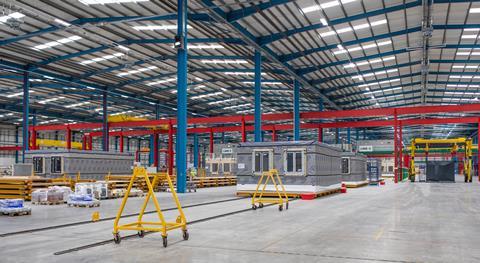Industry players from Mark Farmer to Mike Leonard reflect on the end of production at L&G’s factory in Yorkshire and what it means for the modular development sector. Matilda Battersby reports
Last month insurance giant Legal & General announced it was stopping production at its timber-frame modular housing factory in Sherburn-in-Elmet, West Yorkshire.
The company reported losses of at least £174m and its decision to cease production puts 475Legal & General (L&G) employees at risk of redundancy.

L&G had planned to build 3,500 homes a year from its plant, but had “not been able to secure the necessary scale of pipeline” to achieve this.
The cessation of production at L&G follows a number of recent difficulties in the industry, including the collapse of Urban Splash Sekisui and Caledonian Modular, and problems at Countryside and Swan.
We asked industry experts to respond to the news and offer insights into the future of modular methods of construction (MMC) in view of the move by L&G.
What the MMC tsar says:
Mark Farmer, a construction and real estate expert appointed as the UK government’s champion for MMC in housebuilding in 2019, remains optimistic about its future. He points out that the volumetric residential modular market which L&G contributed to is just a small part of the wider MMC market.
“Volumetric is quite rightly a high profile example of MMC, but it is important to remember this is only one of seven defined categories and is actually one of the smallest current segments in terms of project adoption,” he told Housing Today.
“It is also fair to say that there are success stories in residential apartment volumetric modular and there is a solid but small scale SME low rise volumetric market successfully operating across multiple market sectors, including residential, health, education and defence.
On the same day that L&G Modular announced it was scaling down, L&G-owned Cala Homes announced it had acquired Taylor Lane, a leading timber-framing business
“The real challenge here is to understand the longer term ramifications of the L&G story for the large scale residential volumetric market, where L&G Modular were, whatever way you look at it, seen as a great hope for the future disruption of residential development.”

He points out that at least half of the 230,000 new homes built last year had one or more of the seven categories of MMC as defined by the government used in them.
He adds: “It has also been largely overlooked that, on the same day that L&G Modular announced it was scaling down, L&G-owned Cala Homes announced it had acquired Taylor Lane, a leading timber-framing business.
”I see this as significant as the volume housebuilder sector starts to pivot to a world where the impending Future Homes Standard requirement to reduce operational carbon, ESG investor-led requirements to reduce embodied carbon and ongoing traditional trade skill shortages start to threaten business-as-usual delivery.”
What the trade body for MMC says:
Steve Cole, director of Make UK Modular, the trade body for volumetric modular housing in the UK, argues that the L&G decision does not impact the bigger picture, which is still promising for MMC. He predicts the industry is still on target in the longer term.
“It is disappointing to see L&G step back from modular in an extremely difficult housing market for all builders,” he told Housing Today. “It is important to remember that, in the midst of a national housing crisis, fraught with planning difficulties and a chronic labour shortage in the construction sector, modular housing will continue to play a major role in the delivery of high quality, green homes which are significantly cheaper to heat and run than traditionally built housing.
Modular housing will continue to play a major role in the delivery of high quality, green homes
“Ultimately, the L&G decision doesn’t affect the wider macro picture. It obviously has an impact on the sector, in the short term. But the fact is that we need higher quality green homes and the fact is that we need more players in the industry as well.”
He adds: “We’ve re-run our forecast numbers, which we do every year, and we’re still very confident about the sector’s ability to deliver 30,000 homes a year by 2030. We think those numbers are unchanged in light of the L&G news and we are positive on the future of the sector because the underlying need for it is undeniable.
“Make UK Modular is confident that the modular sector will continue its current total growth trend and remain on track to deliver 30,000 new modular homes a year by 2030.”
What a champion of traditional building says:
Mike Leonard, chief executive of the Building Alliance, which champions traditional building methods, believes the move by L&G is an opportunity for government and industry to reevaluate its wider building approach and the role of MMC within policy objectives.
“The L&G closure is obviously regrettable for the people who lost their jobs. But unfortunately, this is a case of public money being used almost indiscriminately to fund a particular method of construction over another,” he told Housing Today.
Modular relies on building out of standard boxes, which plays havoc with planning requirements and public perception as to what ‘good’ looks like
“The thing about modular construction, apart from the fact that it relies heavily on Chinese steel for its raw materials, is it also relies on building out of standard boxes, which plays havoc with planning requirements and public perception as to what ‘good’ looks like in terms of the built environment.
“The forcing through of this policy, if you like, which is supported by governments and Homes England and reflected in the grants that are given to local authorities, is fundamentally at odds with the market requirements. It is also out of touch with our need to build out of materials and buildings that are going to be resilient to severe weather events, and even wildfires.
“From an economic resilience perspective, we need to build using materials that are produced in the UK and use local skilled labour, creating jobs and opportunities. That speaks to the levelling-up agenda.
“The amount of conscious bias that has been shown by Homes England towards requiring 25% of construction in the public sector to be MMC, even though it costs more money, is damaging the British manufacturing industry.
“In much the same way the UK government backtracked on its plans for smart motorways, it should think long and hard about its policies to drive construction in a particular way. It should instead focus on setting the policy objectives, performance objectives, your site for the built environment, and allowing industry to make the decisions as to how those should be fulfilled.”
>> Also read: L&G Modular’s closure shows there’s a limit to the patience of slow capital
What modular homebuilders say:
Other industry players including ilke Homes and TopHat argue that the L&G closure reflects wider market conditions, but suggests they are solvable over the long term with adequate levels of investment.
“The problems faced by L&G Modular – namely planning delays, macro events and labour shortages – are not exclusive to the modular housing sector, with builders across the country facing similar conditions,” an ilke Homes spokesperson said.
Problems faced by L&G Modular – namely planning delays, macro events and labour shortages – are not exclusive to the modular housing sector
“The decision among blue-chip investors to participate in recent fundraising rounds by ilke Homes and TopHat acts as a huge vote of confidence in the modular housing sector.
“ilke Homes is a well-established business with a workforce made up of over 1,000 team members and a pipeline that exceeds 4,000 homes. As a company, we remain highly positive about the years ahead as we continue to pioneer high-quality, zero-bills solutions to house building.
He added: “Investing upfront in capital-intensive manufacturing capability will help address growing skills shortages in construction, and we are proud of the training and employment opportunities now being provided at our Yorkshire facilities. Without the kind of investment we are making, Britain will not be able to achieve the capacity needed to tackle the housing and climate crises.”
A TopHat spokesperson said: “It is sad to hear the news about L&G’s modular business, but while this news reinforces the fact that the modular sector is still nascent when compared to traditional home building, it doesn’t diminish its huge potential and the vital role modular will play in addressing the housing crisis.
The challenges faced by L&G Modular were not exclusive to the modular housing sector – issues such as planning delays and build-cost inflation are being faced across the construction industry.
“Importantly not all businesses in the sector are the same – scale and investment do matter but so too does the specific business model, including the materials the homes are built with, the design and technology used, and the way in which each business works with customers to build its pipeline.
“TopHat continues to operate with great confidence in the sector having recently secured substantial new funding and building the most state-of-the-art home building factory in Europe, which will begin operating in 2024 to deliver more of the high-quality, energy-efficient homes that the UK so badly needs.”
What an MMC architect says:

Mike De’Ath, a partner at HTA Design LLP, a design-led, multi-disciplinary consultancy to the housing and regeneration sector, believes the problems faced by L&G also reflect the market stresses, but that the labour shortage in building means modular is more important than ever.
“I think it’s really sad to see the troubles L&G have had and we have to celebrate them as pioneers. I think it just goes to show how complicated the operating environment is for everybody in the housing industry. The stats from the traditional sector are pretty shocking, with a number of traditional contractors going to the wall.
The L&G decision is by no means a death knell for modular housing
“Modular housing is not immune from what we all face in housing, which is a really devastating combination of inflation, a government that has set itself against housing delivery and changes in regulation and so on. The economic impacts of last September’s mini-Budget and interest rates going up again this month are not going to do much for confidence generally.
“But the L&G decision is by no means a death knell for modular housing. In fact, if you look at the impacts of labour inflation on construction and the number of people now leaving the construction workforce, everything we already know about a lack of capacity is going to really hit us.
“The simple fact is we need more homes. We haven’t got enough skilled people entering the industry and, at the same time, we want to build in a more sustainable way. As a result, I would argue that modular has extremely good prospects for the future as we struggle to meet our building targets with a diminishing workforce.”



























1 Readers' comment